Remington Timeline: 1934 – Guns of Bonnie & Clyde
April 1, 1934 was a quiet Easter morning for Texas Highway Patrol officers H.D. Murphy and Edward B. Wheeler as they patrolled Route114 outside of Grapevine, Texas. The two troopers saw a lone car on a side road and stopped their motorcycles to see if it was a motorist who needed assistance. As they approached the car two men emerged from it and began firing at the troopers both of whom fell to the ground badly wounded. Then a small woman walked up to them and shot both again with a sawed off shotgun, killing them instantly. The Clyde Barrow gang had struck again.
The 1920s and early 1930s were a hard time for America. The passage of the Prohibition Act (1920 – 1933) led to the rise of organized criminal gangs who manufactured or smuggled illegal liquor into the country and often fought “wars” over territory. The Great Depression of 1929 saw millions unemployed, a general dislocation of society and widespread disregard for the rule of law and order.
The so-called “Roaring Twenties” and “Lawless Thirties” were times of great social change and economic unrest with all its attendant problems. A new class of criminal arose who were equipped with modern firearms and displayed a willingness to use violence. Murderous criminals such as John Dillinger, “Baby Face” Nelson, “Pretty Boy” Floyd and Ma Baker – and their gangs – spread terror as they robbed banks, stores, express offices, National Guard armories and gas stations across the Midwest leaving a trail of dead police officers and civilians in their wake.
This crime wave was made possible in great part by the newly popular automobile which allowed gangsters to commit crimes, escape quickly, and elude pursuit. Automobile bodies of the day were made from heavy gauge steel, which in some cases provided these mobile criminals with a kind of “armored” vehicle. The infamous Clyde Barrow and Bonnie Parker – were vocal in their preference for Ford V-8 automobiles because their powerful engines permitted him to outrun most police cars while the heavy metal bodies provided excellent protection from handgun bullets.
The Barrow GangClyde Barrow (March 24, 1909 – May 23, 1934) was born into a poor farming family in Ellis County, Texas. He was first arrested at age 17 for stealing a car and over the next few years was arrested several time for various crimes until, in 1930, was sent to a state prison farm where he killed another inmate who reported sexually assaulted him. He was paroled in 1932 a hardened criminal. Another inmate said he saw Clyde “…change from a schoolboy to a rattlesnake.” After his parole he returned to crime, robbing grocery stores and gas stations.
Bonnie Parker (October 1, 1910 – May 23, 1934) was born in Rowena, Texas. She dropped out of school at 15 and married Roy Thornton but she and her husband split up shortly afterwards although they never divorced. She met Clyde at a mutual friend’s house in July 1930 and apparently fell in love immediately. She was first arrested during a failed store robbery and spent several months in prison.
Upon her release she and Clyde embarked upon a crime career that saw them travel from Texas to Minnesota. During their criminal spree, which lasted only about two years, they were responsible for the deaths of 13 law enforcement officers and civilians. At times they were joined by several other criminals to form the so-called “Barrow Gang”, including Clyde’s brother Buck Barrow and his wife, Blanche, W.D. Jones, Henry Methvin, Raymond Hamilton, Joe Palmer and Ralph Fults.
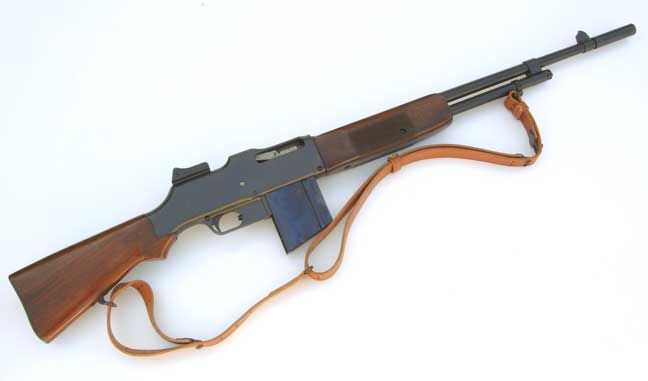
They moved often, seldom staying in one place too long. On two of the occasions when they did, the gang rented a garage apartment in Joplin, MO in 1933 and during an extended stay that same year at a motor court in Platt City, MO they were caused suspicions among the locals leading to the police raiding their residences. Both resulted in violent shootouts that saw them escape by car although several of the gang were wounded, including Buck Barrow, who eventually succumbed to a massive head wound.
During these shootouts the gang displayed massive firepower that overwhelmed the police.
Clyde’s BAR
In 1932 a criminal acquaintance, Herbert Farmer, gave Clyde two Browning Automatic Rifles (BAR) he had stolen from a Missouri National Guard armory. Clyde immediately became enamored with the BAR because of its high rate of firepower and it’s .30-caliber bullets’ ability to penetrate automobile bodies easily. Apparently he maintained them carefully and always kept a couple of loaded guns within reach.
In 1933 Clyde and W.D. Jones robbed National Guard armories in Enid, OK and in Plattville, IL. The booty from these robberies included several more BARs, Colt 1911 pistols, riot shotguns, various M1917 revolvers and large quantities of ammunition and magazines.
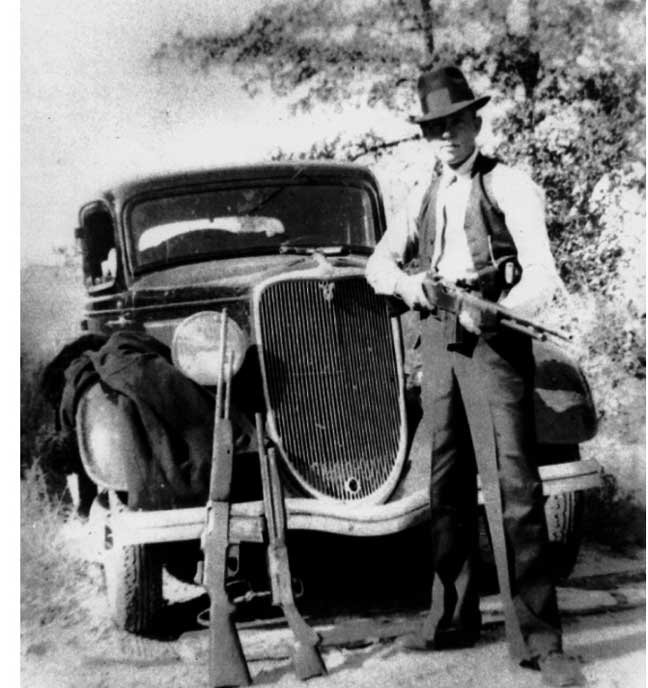
The gang also obtained weapons by robbing hardware stores and taking them from police officers and bank guards they either killed or captured. In addition to the BARs and 1911s their arsenal eventually included Colt revolvers and pistols, S&W revolvers in various calibers, a variety of pump action and semiauto shotguns and even a M1899 Krag-Jorgensen cavalry carbine.
Bonnie’s ShotgunWhile Clyde’s BARs got most of the press attention, one of the gang’s shotguns became just as famous. There are a number of photographs of the gang members posing with their weapons, among which are several Remington semiauto Model 11 shotguns.
Developed by John Moses Browning between 1898 and 1900 it was first manufactured by Fabrique Nationale (FN) in Belgium as the Auto 5 shotgun. In 1906 Remington began production in the U.S. and would continue until 1947.
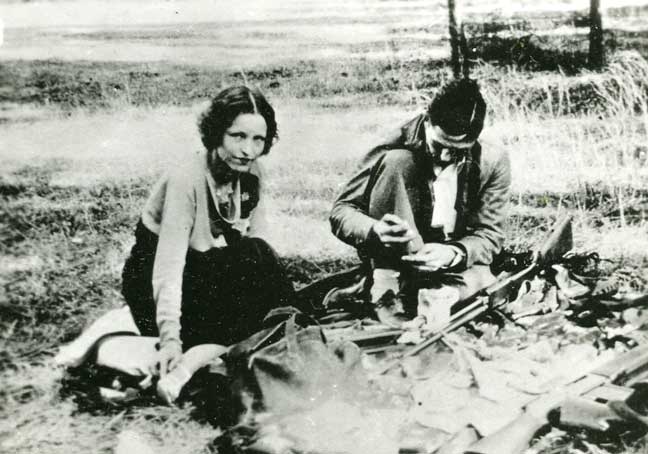
It used a long-recoil operating system. When a shell is fired, the barrel and bolt recoiling together (for a distance greater than the shell length) re-cock the hammer, eject the spent shell as the barrel moves forward, and feeds another shell from the magazine. It had a distinctive squared off (humped back) receiver and a four round tubular magazine under the barrel. Originally made in 12 gauge, 20 and 16 gauge guns were introduced in 1931 – 1932.
It proved very popular with sportsmen and Remington introduced a Riot Gun version with a 20-inch cylinder bore barrel, large numbers of which were purchased by police agencies and the U.S. Army.
Specifications: Remington Model 11 Shotgun
Caliber: 12, 16 & 20 gauge
Overall length: 45 in. (with 26-in. barrel)
Barrel length: 20, 26, 28 & 30
Weight: 7.7 lbs.
Magazine capacity: Four rounds
Sights: Front: metal bead
Rear: none
Stock: Walnut, straight or pistol grip
All of the Model 11s seen in Barrow gang photos have short barrels and the buttstocks have been cut off just behind the pistol grip. Reportedly Bonnie’s personal gun was a 20-gauge Model 11 with the barrel cut off just in muzzle and the stock shortened as mentioned above. There are several famous photos of her and Clyde with her brandishing the gun.
Shotguns such as Bonnie’s were known as a “whippet guns” (sometimes spelled “wippet”). The term reportedly originated on the 19th century Western frontier to indicate a short-barreled shotgun that could be concealed under a long jacket or duster hanging under the arm from a leather strap over the shoulder and “whipped” out when needed. Reportedly Bonnie devised a special trick pocket for Clyde, one where his right trouser was zippered so that he could carry a sawed-off shotgun next to his leg and then, employing the break-away zipper, whip the gun out and fire in one motion.
Bonnie’s Model 11 was never far from her side and it was on the floorboard on her side of the “death car” when they were ambushed.
The gang continued their travels robbing stores and banks as they went along. They were never hesitant to shoot any police officer or civilian who they saw as a threat. Oddly enough, on occasion they would kidnap the victim and keep him/her for several days before releasing them, often with some money to help them get home.
With their new notoriety, their daily lives became more difficult, as they tried to evade discovery. Restaurants and motels became less secure and they resorted to living in their car or camping out cooking their meals over open fires and bathing in cold streams. Reportedly they were often dirty and smelled bad.
On January 16, 1934, Barrow orchestrated the escape of Raymond Hamilton, Henry Methvin and several others in the infamous “Eastham Breakout” of 1934 during which a prison guard was killed. The brazen raid generated negative publicity for Texas, and Barrow seemed to have achieved what historian Phillips described as his overriding goal, “getting revenge on the Texas Prison System.”
The Manhunt BeginsThe Texas Department of Corrections contacted former Texas Ranger Captain Frank A. Hamer, and persuaded him to hunt down the Barrow Gang. Though retired, Hamer accepted the assignment as a Texas Highway Patrol officer, secondarily assigned to the prison system as a special investigator.
Hamer studied Clyde’s movements carefully and discovered that the gang swung in a circle, skirting the edges of five Midwestern states, exploiting the “state line” rule. Barrow was consistent in his movements, so the experienced Hamer charted his path and predicted where he would go. The gang’s itinerary centered on family visits, and they were due to see Methvin’s family near Bienville Parish, Louisiana. Unknown to Clyde, Methvin’s father had been persuaded to help Hamer in return for a lighter sentence for his son.
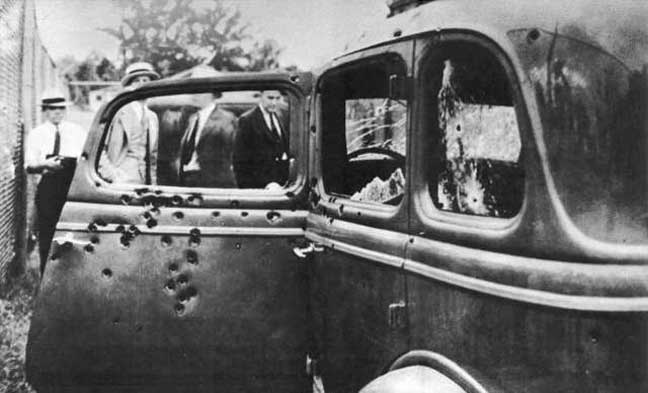
Hamer organized a “posse” consisting of Dallas County Sheriff’s Deputies Bob Alcorn and Ted Hinton (both of whom knew Barrow and Parker by sight), former Texas Ranger B.M. “Manny” Gault, Bienville Parish Sheriff Henderson Jordan and his deputy Prentiss Oakley.
Hamer had no intention of trying to take the criminals alive and so he equipped his “posse” with overwhelming firepower. Hamer chose a semiautomatic, .30-caliber Remington Model 8 rifle while Prentiss Oakley armed himself with .35-caliber Model 8 that he borrowed from a friend. Ted Hinton had a BAR “on loan” from the Texas National Guard. Manny Gault had a Hamer’s old .25-caliber Model 8 while Sheriff Jordan carried a Model 94 Winchester. Several of them were also armed with Remington Model 11 shotguns and all had handguns (Hamer’s was a .38 Super Colt 1911A1).
Released on the market in 1906 as the Remington Autoloading Rifle (it was renamed the Model 8 in 1911) had a number of mechanical and cosmetic similarities to Browning’s Model 11 shotgun: both operated on the long recoil principal and used distinctive, hump backed receivers. But the rifle differed in that the barrel was encased in a full-length metal jacket, which contained the recoil and buffer springs inside of an inner tube (known as the “recoil spring case”).
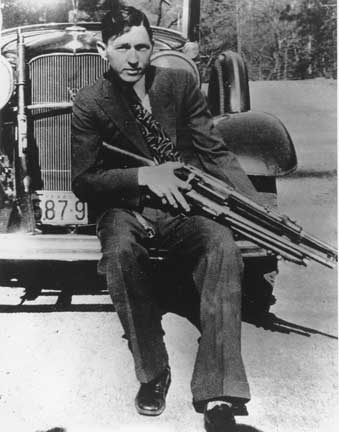
The safety was a lever on the right of the receiver which, when moved up, lockedthe sear and trigger and covered the bolt handle slot to keep debris out of the receiver. A non-detachable box magazine was located in front of the trigger guard and could be loaded through the open receiver with single rounds or with five round chargers (stripper clips) that were supplied with each rifle. Originally chambered for the .35 Remington cartridge, they were eventually produced in .25, .30 and .32 Remington.
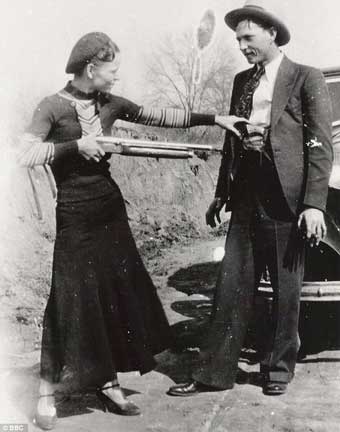
Thanks to its high rate of firepower, the law enforcement community found the Model 8 attractive. Local police departments and prestigious agencies, such as the Investigative Division of the Department of Justice (forerunner of the FBI), purchased them while the Texas Rangers adopted the .25-caliber Model 8 as their issue rifle. Many police officers purchased them privately and they were very popular with U.S. Border Patrol agents.
Specifications: Remington Model 8 Rifle
Caliber: .25, .30, .32 & .35 Remington
Overall length: 41.25 in.
Barrel length: 22 in.
Weight: 7.7 lbs.
Magazine capacity: Four rounds (.35), five rounds (.25, .30 & .32)
Sights: Front: White metal bead
Rear: U notch adj. for elevation
Stock: Walnut, straight or pistol grip
To meet demand from police departments for more firepower to combat the criminal gangs of the era, in 1928 the Peace Officer Equipment Company of St. Joseph, MO began selling .30- and .35-caliber Model 8 rifles modified to accept a detachable, 15-round magazine. Less expensive (and more powerful) than the Thompson Submachine Gun, numbers were sold to various agencies while many officers purchased them privately.
The AmbushHamer and his men set up an ambush for Bonnie and Clyde on May 23, 1934 along a country road where Methvin’s father had parked his truck to attract them. As the criminal pair drove down the road they slowed their V-8 Ford down to speak with Methvin and the posse opened fire.
It appears that Prentiss Oakley fired before Hamer gave the word and the first two shots from his Remington Model 8 hit Clyde in the head, killing him instantly. According to statements made by Hinton and Alcorn:
Each of us six officers had a shotgun and an automatic rifle and pistols. We opened fire with the automatic rifles. They were emptied before the car got even with us. Then we used shotguns … There was smoke coming from the car, and it looked like it was on fire. After shooting the shotguns, we emptied the pistols at the car, which had passed us and ran into a ditch about 50 yards on down the road. It almost turned over. We kept shooting at the car even after it stopped. We weren’t taking any chances.
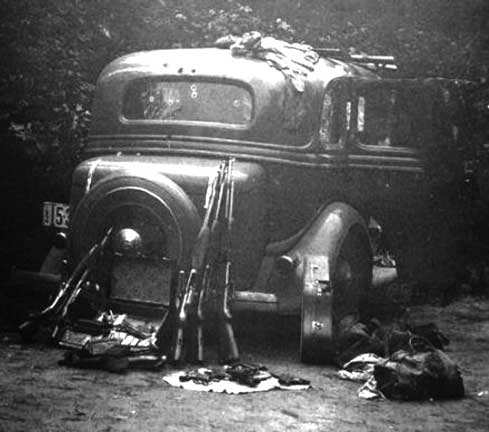
The posse fired in excess of 130 rounds at the criminal car. According to the coroner, Bonnie was hit at least 17 times while Clyde’s body had 27 bullet wounds. Officials found Bonnie’s Model 11 near her feet on the car’s floorboards, a .38 Colt Detective Special revolver taped to her thigh and a Colt .25 automatic in her purse. Sources disagree as to what Clyde was carrying on his person. Some said he was carrying a 1911 pistol while others claimed in was a .45-caliber M1909 Colt revolver.
After the shootout police found the following weapons in Clyde’s car:
Three .30-caliber BARs
One 20-gauge Model 11 shotgun (Bonnie’s)
One 10-gauge Winchester Model 1901 lever-action shotgun
One .32-caliber M1903 Colt automatic pistol
One .38 Colt Detective Special revolver (Bonnie’s)
One .25-caliber Colt automatic
One .45-caliber Colt M1909 revolver
Seven .45-caliber M1911 automatic pistols
100 loaded BAR magazines
3000 rounds of assorted ammunition
15 sets of license tags from various states
Bonnie and Clyde died as they had lived—in violence. Bonnie’s estranged husband Roy Thornton opined: “I’m glad they went out like they did. It was much better than getting caught.”




